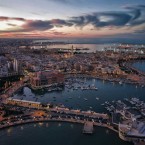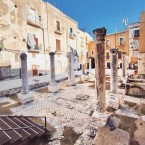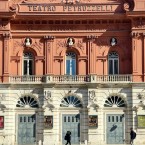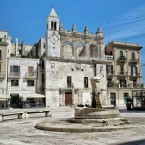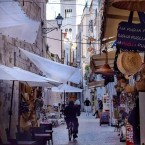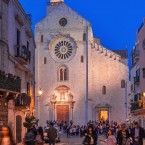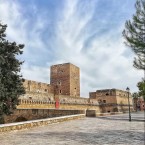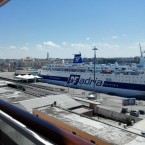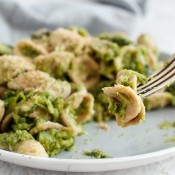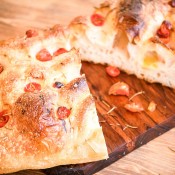Information about Bari
Capital of the Puglia region, Bari plays a fundamental role in relations with the countries bordering the Mediterranean, thanks to the strategic function of the port, the airport and the Fiera del Levante.
The port of Bari, port of Levante, is a multipurpose port with a passenger traffic of almost 2 million units per year. It is one of the most important ports on the Adriatic for the transport of people and goods to Albania. The port area is divided into two areas, one dedicated to commercial and passenger traffic that offers many services such as free and guarded car parks, shops, markets and ATM services, and the other reserved for fishing activities and small private boats. The city of Bari is a fascinating discovery, and its two faces, the elegant Murattian district and the hypnotic old Bari, nestled on the Adriatic.
The grand Swabian Castle, crowned by towers, once a defensive manor, then a Renaissance residence, acts as a gateway to the old city. Crossing the Arco del Pellegrino, you arrive in the heart of the Nicolaiana Citadel, with the Basilica dedicated to the patron saint, a fine example of Apulian Romanesque, and the Romanesque Cathedral of San Sabino, with its Baroque-style crypt.
In the nineteenth-century Bari Murattiana, noble palaces such as the Petruzzelli Theater, the Piccinni Theater and Palazzo Fizzarotti parade, while the subsoil holds hidden treasures, rock churches and hypogea dug into the rock, such as the Temple of San Giorgio, the hypogeum of Madia Diana and the "Jewish" hypogeum.
Tourist and seaside offer
The historic center of Bari, a maze of alleys, courtyards, historic and local buildings, is a city within a city, with about 30 churches and wonderful architecture such as the Basilica of San Nicola, the Romanesque Basilica of San Gregorio, the Cathedral of San Sabino and the Norman-Swabian Castle, commissioned by Frederick II. On the largest seafront in Italy, Bari Vecchia is the ancient heart of the city, between the scent of laundry, freshly baked focaccia and fresh pasta put to dry in front of the doors, along Arco Basso and in the area between Piazza Ferrarese, Piazza San Pietro and the Monastery of Santa Scolastica. Also worth visiting are Piazza Mercantile, the infamous Column and the Library of Santa Teresa dei Maschi. Surrounded by the Adriatic for three quarters, Bari has an almost symbiotic relationship with the sea. A large part of the local economy hinges on the sea, thanks to the mercantile activities in the New Port and the Old Port. The Apulian capital is also an important communication pole with Eastern European countries and ferries depart for Croatia, Greece and Albania from the tourist port of the city. To go to the sea like the real people of Bari, the address is Pane e Pomodoro, a renowned free beach and meeting point for bathers in the city, together with Lido San Francesco and there are also numerous bathing establishments where you can try your hand at windsurfing, rowing and sail.
What to do in Bari
A university city and an important crossroads with the East, Bari is a fun and lively destination all year round, with numerous cultural initiatives, live music and food and wine events. The historic center swarms until late at night, between Piazza Ferrarese, the heart of the nightlife in front of the port, and Piazza Mercantile, with pubs, lounge bars and restaurants. Behind the walls, beer gardens and cafes light up the promenade until the first light of dawn, with outdoor concerts, meetings, shows and tastings. It was the ancient fair of the Kingdom of Naples and, even today, it remains unique in the whole Mediterranean. The Fiera del Levante, on the Bari seafront, is an important international exhibition center, widely versatile, with three hundred thousand square meters available and an optimal strategic position, about 2 km from the city center and only 15 minutes from the airport, connected to the major viability. The property has 6 entrances, including the majestic monumental entrance overlooking the sea. Known throughout the world as Santa Claus, St. Nicholas is the patron saint of the city on the Adriatic and the Nicolaiana Citadel in the historic center, with the majestic Basilica where the Miraculous Column and the Tomb of the saint are kept, is today an important pilgrimage destination for Catholics and Orthodox, a constant flow of faithful mainly from Eastern Europe.Do not miss the celebrations of St. Nicholas, patron saint, in December and May, with the Caravella Historical Parade.
What to eat in Bari
It is the homeland of orecchiette, curious little domes of fresh pasta prepared, according to the traditional recipe, with turnip greens. Bari boasts a varied gastronomic offer, from fragrant focaccias from Bari to first courses of sea and land, up to the excellent local wine.Typical of Bari is also the famous ciambotto, a fish ragù obtained from a mixture of several specialties, all rigorously fished in the Adriatic Sea. Bari is also famous for raw fish, a mix of cuttlefish, octopus and seafood which is an excellent street food, and for the traditional "tiella", made with rice, potatoes and mussels.


